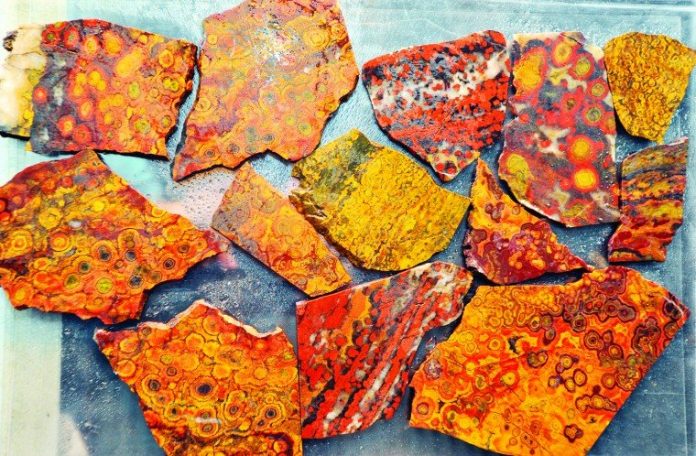Jeff Parker jokes that his neighbors must “think I’m a weirdo.”
The 60-year-old “rock hound” dons a rain jacket while tinkering away on his front lawn, using a special tool called a “wet stone grinder” to craft a bowl made of solid Poppy Jasper.
Parker’s handheld polisher/grinder dispenses a steady flow of water through a special valve, keeping the semi-precious mineral cool and lubricated. Water tinted pink with traces of the iron-rich jasper sprays everywhere during the process, Parker explains.
Hence, the rain gear.
“He never does it in the house. My mom would be so mad,” says his daughter Amy Bou, a 27-year-old Gavilan College nursing student. “He has the whole garage to himself, so it’s like his little man cave…but with rocks.”
Like the polished stones arranged in a spinning display case inside Parker’s busy A-1 Saw & Lawn Mower shop behind Rocca’s Market in San Martin, Poppy Jasper is to the Morgan Hill area as garlic is to Gilroy: A ubiquitous component of the community’s identity and character.
A meteor-like hunk of the stuff sits on display inside a special case inside the Morgan Hill Community and Cultural Center. Patrons of the El Toro Brewing Company can relax at a custom-designed, 40-foot long wraparound bar inlaid with the rare orbicular jasper while sipping the award-winning Poppy Jasper Amber Ale. A row of homes line Poppy Jasper Lane near the intersection of Cochrane and Monterey roads. The City of Morgan Hill – the website template for which subtly reflects the kaleidoscopic red and yellow spheres found in the microcrystalline variety of quartz unique to Morgan Hill – has a “Poppy Jasper” ceramics room. A popular film festival running nine years and counting takes its name from the mineral, even embedding a piece of Poppy Jasper into each of the award plaques so filmmakers and attendees can “walk away with a piece of Morgan Hill.”
The funny part, says Parker, is “there’s many people in Morgan Hill that don’t even know what it is. They think it’s a film festival…but it’s not. It is a rock.”
Morgan Hill’s official “city rock,” in fact, isn’t actually a rock, according to Engineering Geologist Peter Anderson with Morgan Hill Pacific Geotechnical Engineering.
Whoops.
“It’s sort of funny, because City Council of Morgan Hill decided to adopt Poppy Jasper as our official ‘city rock’…even though it is just a mineral,” he chuckled.
In 2002 Poppy Jasper was named Morgan Hill’s official rock, making the city one of a few in the country with its own rock, or, mineral.
Sure, Anderson’s getting technical and “esoteric” on us. But it comes with the territory when you’re a “geo-geek.”
Recognizably distinct for its psychedelic patterns of red and yellow circles that often resemble an iris, splotchy lichens, sea anemones, a miniature version of Jupiter’s Great Red Spot – or, most notably, the orange, yellow and red flower from which its name is inspired – Poppy Jasper is a form of chalcedony, or translucent variety of quartz. The stuff was formed through a combination of volcanic and seismic activity on the slopes of El Toro millions of years ago when woolly mammoths and saber-toothed tigers still roamed the planet, according to Anderson.
The mineral was first created by the slow cooling of a hot liquid composed almost entirely of silica dioxide – most commonly found in nature as sand or quartz. When the earth shifts, different elements or minerals get infused into that liquid silica body, Anderson explains. Most commonly, this element is some type of iron oxide – “typically what you and I call rust,” he says.
Poppy Jasper is a type of orbicular jasper, denoting its needle-like crystals that aggregate around one nucleus and grow spherically. Slowly but surely, “these little orbs begin to form,” Anderson explains.
Discoloration occurs when another element, or contaminate gets into that clear silicon dioxide formula. This results in those familiar brick reds, mocha browns, coal black, sunflower yellows and creamy hues and streaks of white that make each piece of Poppy Jasper so wonderfully bizaare and eye-catching.
Unpolished, the mineral sometimes resembles a lump of ketchup-red and dull mustard-yellow clay smashed together. After hours of work and about 13 steps required to transform a piece of Poppy Jasper from rough to marble-smooth, the end result causes customers in Parker’s store to ogle at the finished product. Pendant-sized pieces and chunks are priced for sale beginning somewhere around $40, while a group of polished Poppy Jasper spheres (Parker’s personal collection; not for sale) the size of baseballs and softballs are worth up to $400.
Parker is a little squeamish about people picking the spheres up – and understandably. A woman dropped one once.
He’ll leave smaller and medium-sized pieces in a spinning rotary for up to three months, “which is like running it in the creek for a million years,” he says, stopping to shoo away an overly friendly store cat, whose speckled calico coat vaguely resembles Parker’s mineral collection.
A professed “rock puppy” since the ripe age of 8, an interest in rocks got passed on Parker through his grandfather; a Morgan Hill geologist who studied at UC Berkeley and sent home interesting stones while working on the Pan-American Highway. As a young boy, Parker’s grandmother gave him a rock polisher that still works today.
Parker recalls how mineral deposits within the “Poppy Jasper zone” – running 12 miles long and 5 miles wide through the Morgan Hill area – were once common, but have all but vanished under urbanization. Much of the pieces in Parker’s personal collection comes from “horse trading” or long walks along roads, but these days “it is extremely hard to find,” he says.
That, or it’s forbidden fruit on private property.
Poppy Jasper seekers are definitely an ongoing source of frustration, says Mark Good, a Gilroy School Board trustee whose family has resided on the backside of El Toro Mountain since the 1960s.
“We’ve had numerous incidents over the years of theft and vandalism and trespassing,” he said. “That’s been very distressing.”
Even mindat.org, a comprehensive and regularly updated mineralogy database, has a message forum dated Sept. 12, 2006 that warns, “don’t get arrested or shot, as sometimes happens” when hunting for Poppy Jasper on private property near Chesbro Creek or Anderson Reservoir.
Although there are as many types of orbicular jasper as there are types of grains of sand, Poppy Jasper is particularly “renown in the world of mineralogy and in the world of collectors,” says Anderson.
Unfortunately for rare minerals seekers and gung-ho rock enthusiasts, “there is no place any more where Poppy Jasper is on public property – with one exception, the place to go is a store,” says Anderson.
Jasper deposits can be found in regions spanning the globe in Egypt, Australia, Brazil, India, Canada, Kazakhstan, Madagascar, Russia, Uruguay and the U.S. At the Smithsonian National Museum of Natural History in Washington D.C. a slice of Poppy Jasper is identified as natural to Morgan Hill.
With jasper itself having been dubbed “one of the workhorses of the crystal world,” Poppy Jasper seems to have quite the reputation in the study of gemstone healing and lore. The mineral is reportedly credited to encourage a deep connection with the earth, as well as enhancing relaxation, organizational abilities, a sense of completeness, protection and attunement with animals. Other stories claim Poppy Jasper was once used by Native Americans as a sacred stone with the power to bring rain and end droughts.
Anderson chuckles that he “doesn’t hang out in that arena” and isn’t aware of any lore surrounding Poppy Jasper’s supposed healing or metaphysical properties.
What he likes about the intriguing mineral, “is that it’s ours,” he said. “It’s a part of our heritage. We have El Toro the mountain as the backdrop to our city, we have (city founder) Hiram Morgan Hill, and we also have Poppy Jasper. That’s kind of cool. It’s found right here. It’s ours.”















